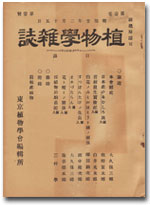All issues

Volume 81, Issue 964
Displaying 1-5 of 5 articles from this issue
- |<
- <
- 1
- >
- >|
-
Flavonoid Glycosides Obtained from the Fronds of Adiantum aethiopicum and A. monochlamysMasao HASEGAWA, Yoko AKABORI1968 Volume 81 Issue 964 Pages 469-472
Published: 1968
Released on J-STAGE: October 31, 2006
JOURNAL FREE ACCESSFlavonoid glycosides contained in Adiantum aethiopicum and A. monochlamys which resemble morphologically each other are compared. In A. aethiopicum, flavonoids detected are prunin (naringenin 7-glucoside) and naringin (naringenin 7-rhamnoglucoside) as flavanone glycosides, and astragalin (kaempferol 3-glucoside), isoquercitrin (quercetin 3-glucoside) and an unidentified kaempferol glycoside as flavonol glycosides. A. monochlamys contains prunin, astragalin, trifolin (kaempferol 3-galactoside), isoquercitrin, hyperin (quercetin 3-galactoside) and unidentified kaempferol and quercetin glycosides. As regards flavonol glycosides, the components of A. monochlamys are additive to those of A. aethiopicum, and the sugars attached to the 3-position of the main flavonol glycosides contained in both species are different from each other.View full abstractDownload PDF (447K) -
IV. Variation in Gross Morphology of M. kamtschaticumShoichi KAWANO, Masaaki IHARA, Masatomo SUZUKI1968 Volume 81 Issue 964 Pages 473-490
Published: 1968
Released on J-STAGE: October 31, 2006
JOURNAL FREE ACCESSPopulation analyses were undertaken in an effort to illustrate the variability of Maianthemum kamtschaticum (Chamisso) Nakai (=M. dilatatum). Regional and correlative aspects of the variability were also analyzed in detail in Japanese populations of various origins. It became apparent that the local populations of M. kamtschaticum have evolved a number of differences proportionately, manifesting a marked geographical cline. A conspicuous decline in variability was noted in the populations from southeastern or western Japan, where this species is regarded to be near the edge of its ecological niche ; whereas a broad range of inter- and intrapopulation variation was found in the bulk of the collections from populations in the northern part of its geographical range, although the northern plants prevailingly bear cauline leaves that on the average are very much enlarged in size compared to those from the southern populations. A somewhat similar trend was observed in the variation pattern of other characters such as scape height, inflorescence length, and so on.
The enormous contemporary geographical differentiation discovered in M. kamtschaticum may have been due to a continual reshuffling of its genetic constitution by selection pressures and through frequent and repeated fragmentation of the local populations into local breeding units of varying size, and their subsequent reunion accompanied in the past by great changes in the environment, determining the rate, change, and disappearance of significant differences in local populations.View full abstractDownload PDF (2909K) -
Masayuki KATSUMI, Yukiyoshi OGAWA, Koichi KOSHIMIZU1968 Volume 81 Issue 964 Pages 491-497
Published: 1968
Released on J-STAGE: October 31, 2006
JOURNAL FREE ACCESSBiological properties of GA18 were compared with those of GA3 in six different assay systems. GA18 was active in leaf sheath elongation of rice, and d1 & d5 mutants of maize, and epicotyl elongation of dwarf pea. The degree of the activity of GA18 was less than 1/10 of that of GA3 in rice and dwarf pea. In d1 and d5 mutants of maize, GA18 was as active as GA3 at the dosages of 0.1 and 1μg per plant. But the activity of GA18 levelled off at 1μg per plant. GA18 also stimulated α-amylase activity in the endosperm of rice. However, longer incubation periods were required for the activity of GA18 to be observed than for GA3. GA18 was inactive in hypocotyl elongation of cucumber and lettuce. The results are discussed in relation to gibberellin biosynthesis.View full abstractDownload PDF (604K) -
N. SHIMOTOMAI, S. ADACHI, S. MASUMORI1968 Volume 81 Issue 964 Pages 498-505
Published: 1968
Released on J-STAGE: October 31, 2006
JOURNAL FREE ACCESSChrysanthemum shiwogiku var, kinokuniense has been known as octoploid (2n=72). By the present investigation, however, a decaploid strain (2n=90) was also discovered in the same variety. The octo- and decaploid strains occur in different but contiguous geographical areas along the Pacific coast of Kii Peninsula. The octoploid strain distributes on the southwestern coast of Kii Peninsula, while the decaploid strain grows along the southeastern coast. The distributions of both strains come to contact with each other at Izumosaki, a locality very close to the southernmost point of the peninsula. Some plants from this and adjacent localities were hybrids between both strains and showed an irregular meiosis, forming variable numbers of univalent chromosomes at metaphase I. In external morphology, effects of hybridization could be detected throughout the distribution areas of both strains. However, the octo- and decaploid strains were rather similar to C. shiwogiku (2n=72) and C. pacificum (2n=90), respectively. These and some other facts suggest that both strains of kinokuniense were originally two different species, C. shiwogiku and C. pacificum, but their external morphology has become continuous through the introgressive hybridization.View full abstractDownload PDF (1684K) -
Naoko KATO, Michi SHIROYA, Seiichi YOSHIDA, Masao HASEGAWA1968 Volume 81 Issue 964 Pages 506-507
Published: 1968
Released on J-STAGE: October 31, 2006
JOURNAL FREE ACCESSDownload PDF (156K)
- |<
- <
- 1
- >
- >|